2021 my country Health and Health Development Statistics Bulletin
Author:Henan Province Health and Heal Time:2022.07.14


2021
Statistics of the development of health and health undertakings
In 2021, the national health and health system conscientiously implemented the decision -making and deployment of the Party Central Committee and the State Council, coordinated the various tasks of preventing and controlling the epidemic, and continuously promoting the high -quality development of health and health undertakings. The per capita life expectancy of residents has increased from 77.93 in 2020 to 78.2 years in 2021. The mortality rate of maternal mothers has dropped from 16.9/100,000 to 16.1/100,000, and infant mortality has dropped from 5.4 ‰ to 5.0 ‰.
one
Sanitary resources
(1) Total number of medical and health institutions.
At the end of 2021, the total number of national medical and health institutions was 1030,935, an increase of 8013 over the previous year. Among them: 36570 hospitals, 9,77790 grass -roots medical and health institutions, and 13,276 professional public health institutions. Compared with the last year, the hospital increased by 1,176, and the grass -roots medical and health institutions increased by 7754. A total of 10 national medical centers and children's regional medical centers in the country are set up in the country.
In the hospital, there were 11,804 public hospitals and 24,766 private hospitals. Hospitals are divided into 3275 3275 hospitals (of which: 1651 three -level hospitals), 10,848 secondary hospitals, 12,649 first -level hospitals, and 9798 unbounded hospitals (see Table 1).
The number of beds in the hospital: 21,909 hospitals with less than 100 beds, 5,412 beds of 100-199 beds, 5017 bed hospitals in 200-499 beds, 2,164 bed hospitals with 500-799 bed hospitals, and 800 and above bed hospitals.
Among the grass -roots medical and health institutions, 36,160 community health service centers (stations) (of which: 10122 community health service centers, 26038 community health service stations), 3,4943 township health centers, 27,1056 clinics and medical departments, village clinics 599292 indivual.
Among the professional public health institutions, there are 3376 disease prevention and control centers, of which: 31 provincial, prefecture (city) level 410, county (district, county -level city) level 2755. There are 3010 health supervision agencies, of which: 25 provincial, prefecture (city) level 315, county (district, county -level city) level 2487. There are 3032 maternal and child health care institutions, of which: 26 provincial, prefecture (city) level 377, county (district, county -level city) level 2,554.


(2) Number of beds.
At the end of 2021, there were 9.448 million beds in medical and health institutions in the country, of which: 7.413 million hospitals (78.5%), 1.712 million primary medical and health institutions (18.1%), and 302,000 professional public health institutions. In the hospital, 70.2%of the public hospitals, and the beds of private hospitals accounted for 29.8%. Compared with the previous year, the bed increased by 348,000, of which: the hospital bed increased by 281,000 (an increase of 116,000 in public hospitals, an increase of 166,000 private hospitals), the beds of grass -roots medical and health institutions increased by 63,000, and beds in professional public health institutions were Increased by 06,000. The number of beds per 1,000 medical and health institutions increased from 6.46 in 2020 to 6.70 in 2021.
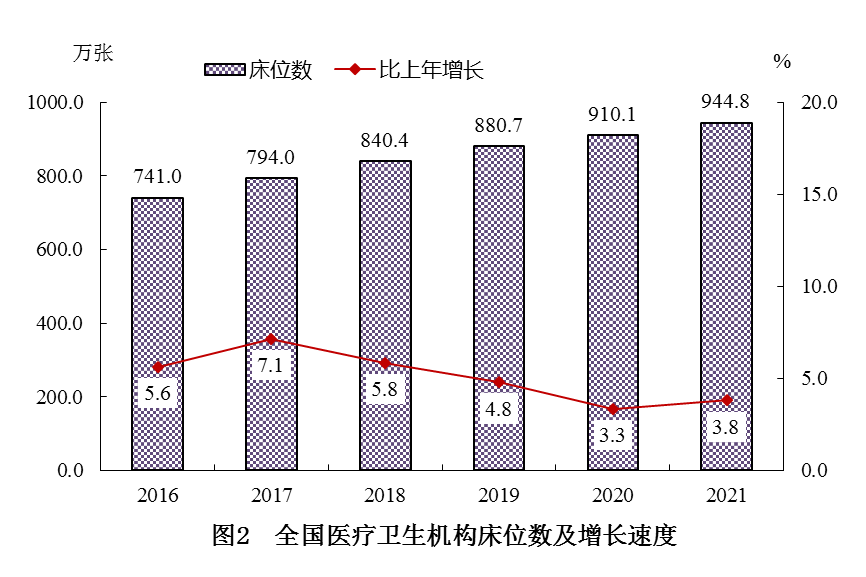
(3) Total number of health personnel.
At the end of 2021, the total number of national health personnel was 13.983 million, an increase of 508,000 (an increase of 3.8%) over the previous year.
In the total number of health personnel at the end of 2021, there were 11.242 million health technicians. Among the sanitation technicians, 4.287 million doctors (assistant) doctors (assistants) and 5.18 million registered nurses. Compared with last year, health technicians increased by 564,000 (increase 5.3%) (see Table 2).
At the end of 2021, the distribution of health personnel institutions: 8.478 million hospitals (60.6%), 4.432 million (31.7%) of grass -roots medical and health institutions, and 958,000 professional public health institutions (6.9%).
In 2021, there were 3.04 physicians per 1,000 population (assistant) physicians, and 356 registered nurses per 1,000 population; 308 per 10,000 generals, 6.79 people per 10,000 public health institutions per 10,000 population (see Table 3).
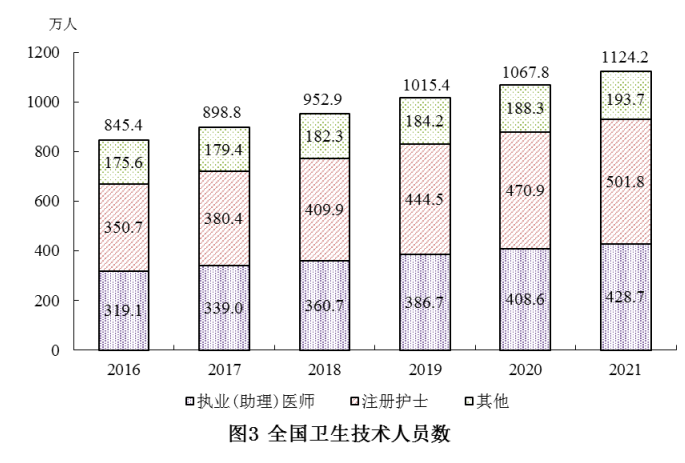

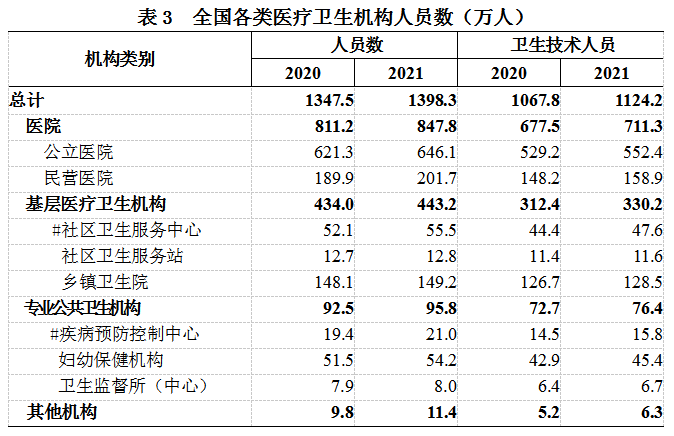
(4) Total health costs.
In 2021, the preliminary calculation of the national total health expenses was 759.36 billion yuan, of which: government health expenditure was 207.185 billion yuan, accounting for 27.4%; social hygiene expenditure was 339.203 billion yuan, accounting for 44.9%; personal hygiene expenditure was 2095.48 billion yuan, accounting for 27.7%. The per capita total hygiene fees are 5348.1 yuan, and the proportion of total health costs accounts for 6.5%(see Table 4).

two
medical service
(1) Outpatient and hospitalization.
In 2021, the total number of diagnosis and treatment of medical and health institutions nationwide was 8.47 billion, an increase of 730 million times (an increase of 9.4%) over the previous year. Residents went to medical and health institutions 6.0 times in 2021. In 2021, the total number of diagnosis and treatment was 3.88 billion (45.8 %), 4.25 billion (50.2 %) of grass -roots medical and health institutions, and 340 million other medical and health institutions (accounting for 4.0 %). Compared with last year, the hospital's diagnosis and treatment increased by 560 million, and the diagnosis and treatment of grassroots medical institutions increased by 130 million.
In 2021, the number of diagnosis and treatment of public hospitals was 3.27 billion (84.2%of the total diagnosis and treatment of the hospital), and the number of diagnosis and treatment of private hospitals (15.8%of the total number of hospitals in the hospital) (see Table 5).
In 2021, the number of diagnosis and treatment of the township health centers and community health service centers (stations) was 2.0 billion yuan, an increase of 150 million people over the previous year. The diagnosis and treatment of township health centers and community health service centers accounted for 23.6%of the total diagnosis and treatment, accounting for 0.3 percentage points from the previous year.
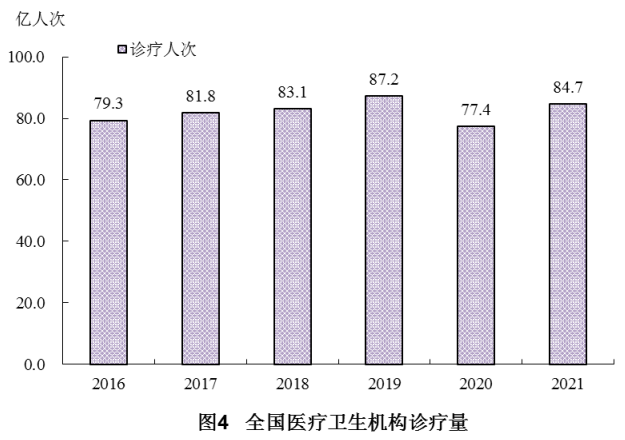
In 2021, the number of admission of medical and health institutions in the country was 247.26 million, an increase of 17.13 million (increased by 7.4%) from the previous year, and the annual hospitalization rate of residents was 17.5%.
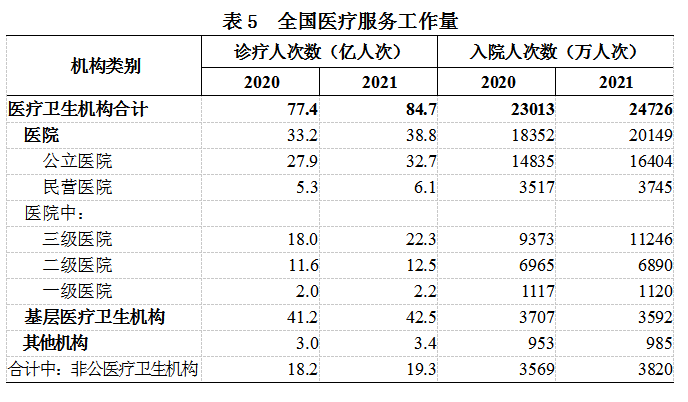
In the hospital in 2021, the hospital's 20149 million person -times (81.5 %), 35.92 million person -times (14.5 %) of grass -roots medical and health institutions, and 9.85 million other institutions (accounting for 4.0 %). Compared with the last year, the hospital was admitted to the hospital for 17.77 million, and the admission of grass -roots medical institutions decreased by 1.15 million. Other medical institutions increased by 320,000.
In 2021, the number of admission of public hospitals was 16.404 million (81.4%of the total number of hospitals in the hospital), and the number of private hospitals was 37.45 million (18.6%of the total number of hospitals in the hospital) (see Table 5).
(2) Hospital physician work load.
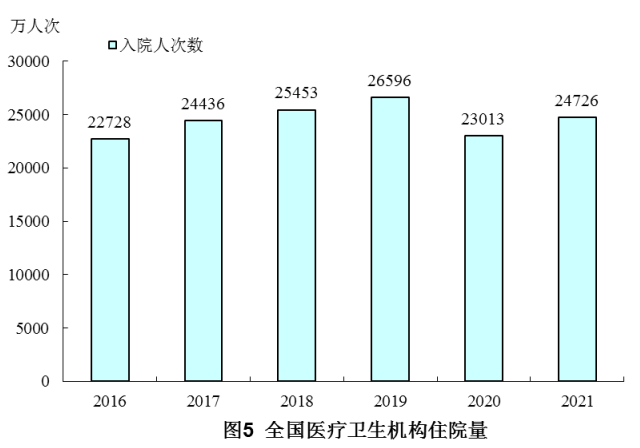
In 2021, the average doctor of the hospital was 6.5 diagnosis and treatment, and the hospitalization of 2.2 beds was daily. Among them, the average daily diagnosis and treatment of doctors in public hospitals and 2.2 beds were hospitalized (see Table 6).
(3) Bed bed.

In 2021, the use rate of hospital beds in the country was 74.6%, of which: 80.3%of public hospitals. Compared with last year, the use of hospital beds increased by 2.3 percentage points (of which public hospitals increased by 2.9 percentage points). The average hospital discharge in the hospital in 2021 was 9.2 days (where: 9.0 days of public hospitals). Compared with the previous year, the average hospital hospitalization date was reduced by 0.3 days (of which public hospitals decreased by 0.3 days) (see Table 7).
(4) Improve medical services.
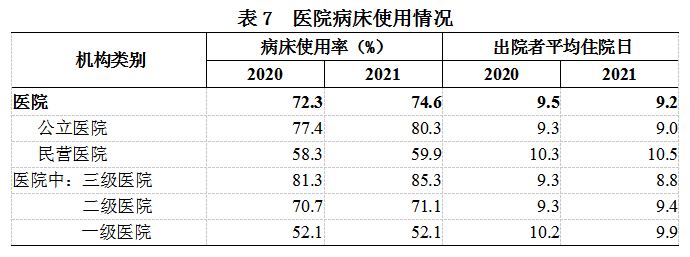
As of the end of 2021, 54.5%of public hospitals in the second and above were launched, 91.3%were managed by 91.3%, 64.6%were conducted remote medical services, 87.6%participated in the results of the same level of inspection, and 92.0%conducted high -quality nursing services.
(5) Blood protection.
In 2021, the number of blood donation of the year reached 16.745 million, and the amount of blood collection reached 28.559 million units, an increase of 7.5%and 8.0%from 2020, and the blood donation rate of thousands of people was 12.
three
Grass -roots sanitary service
(1) Rural hygiene.
At the end of 2021, a total of 1,7294 counties (including county -level cities) hospitals, 1,868 maternal and child health care institutions at the county -level (including county -level cities), 1999 of the disease prevention and control centers at the county -level cities (including county -level cities), and county level (including the county level (including the county level (including The county -level cities) Health Supervision Institute 1761, four types of county -level (including county -level cities) medical and health institutions have a total of 3.521 million health personnel.
At the end of 2021, a total of 35,000 township health centers were set up in 29,600 townships across the country, with 1.417 million beds and 1.492 million health personnel (including 1.285 million sanitary technicians). Compared with last year, the township health center decreased by 819, the beds increased by 27,000, and the number of personnel increased by 11,000 (see Table 8).
At the end of 2021, a total of 599,000 villages were established in 490,000 administrative villages across the country. There were 1.363 million people who worked in the village toilet, of which: 476,000 physicians, 193,000 registered nurses, and 691,000 personnel and health staff with rural doctors. Compared with the previous year, the number of village clinics decreased by 15,000, and the number of practitioners (assistant) doctors increased by 11,000 (see Table 9).

In 2021, the number of diagnosis and treatment at the county -level (including county -level cities) hospitals across the country was 1.31 billion, an increase of 150 million people over the previous year; the number of admission was 83.718 million, an increase of 30.69 million person -times over the previous year; 0.7 percentage points.

In 2021, the number of diagnosis and treatment of township health centers was 1.16 billion, an increase of 60 million over the previous year; the number of admission was 3.2.23 million, a decrease of 16.03 million from the previous year. In 2021, doctors averaged 8.9 diagnosis and treatment, 1.2 beds in hospitalization, 48.2%of beds, and the average hospital hospitalization date was 6.6 days. Compared with the last year, the average daily number of doctors in the township health centers increased by 0.4, and the average daily responsible hospital bed decreased by 0.1 beds. The use rate of beds decreased by 2.2 percentage points. In 2021, the number of diagnosis and treatment of the village toilet was 1.34 billion, a decrease of 90 million people from the previous year, and the average annual diagnosis and treatment of the clinics of each village was 2,239.
(2) Community hygiene.
At the end of 2021, 36,160 community health service centers (stations) have been established nationwide, of which: 10,122 community health service centers, and 26038 community health service stations. Compared with the last year, the community health service center increased by 296, and the community health service station increased by 499. The community health service center has 555,000 personnel, with an average of 55 people per center; 128,000 personnel at the community health service station, with an average of 5 people per station. The number of personnel in the community health service center (station) increased by 35,000, an increase of 5.4%over the previous year.
In 2021, the number of diagnosis and treatment of the National Community Health Service Center was 7 billion yuan, and the number of admission was 3.193 million; the average annual diagnosis and treatment of each center was 69,000, and the number of admission was 315 years. In 2021, the number of diagnosis and treatment of community health service stations across the country was 140 million, with an average of 5,379 diagnosis and treatment of each station, and the average daily doctor of the doctor was 11.0 (see Table 10).
(3) Basic public health service projects.
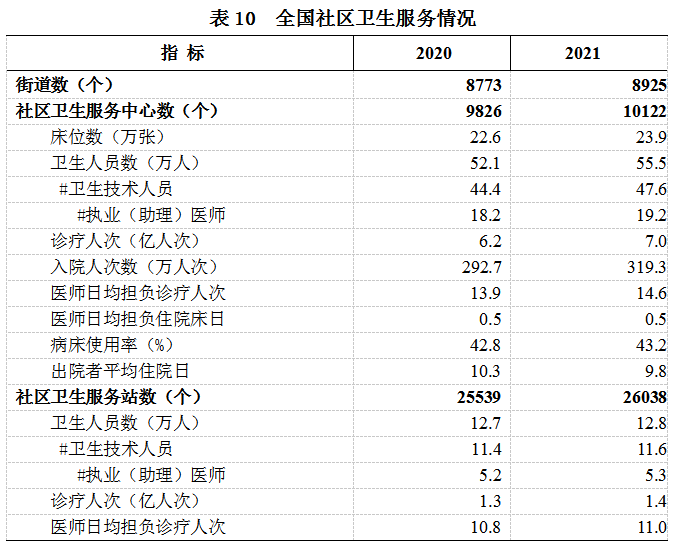
The per capita financial subsidy standards for basic public health services have increased from 74 yuan in 2020 to 79 yuan in 2021. In 2021, the number of elderly people who received health management in the primary medical and health institutions were 119.412 million over the age of 65 and above.
Four
Chinese medicine service
(1) TCM institutions, beds and number of personnel.
In 2021, the total number of traditional Chinese medicine medical and health institutions nationwide was 7,7336, an increase of 4,981 over the previous year. Among them: 5715 traditional Chinese medicine hospitals, 71,583 Chinese medicine outpatient clinics, clinics, and 38 traditional Chinese medicine research institutions. Compared with the previous year, 233 Chinese medicine hospitals increased, and the Chinese medicine outpatient clinic and clinic increased by 4,753 (see Table 11).
In 2021, there were 1.505 million beds in traditional Chinese medicine medical and health institutions, of which 1.197 million (79.5%) of TCM hospitals. Compared with last year, the beds in traditional Chinese medicine medical and health institutions increased by 72,000, of which: the beds of traditional Chinese medicine hospitals increased by 49,000.
In 2021, the community health service centers providing Chinese medicine services accounted for 99.6%of similar institutions, 93.0%of community health service stations, 99.1%of township hospitals, and 79.9%of the village clinics (see Table 12).

In 2021, the total number of Chinese medicine and health personnel in the country reached 884,000, an increase of 55,000 (6.6%) over the previous year. Among them: 732,000 physicians (assistant) doctors and 136,000 doctors (assistant) doctors. Both types of personnel have increased compared to the previous year (see Table 13).
(2) Traditional Chinese Medicine Medical Services.

In 2021, the total number of diagnosis and treatment of traditional Chinese medicine medical and health institutions across the country was 1.2 billion, an increase of 140 million times (an increase of 13.7%) over the previous year. Among them: 690 million people (57.3%) of traditional Chinese medicine hospitals, 2 billion people (17.0%) of TCM outpatient clinics and clinics, and 310 million people in the Chinese Medicine Clinical Department of TCM Medical Institutions (25.7%).
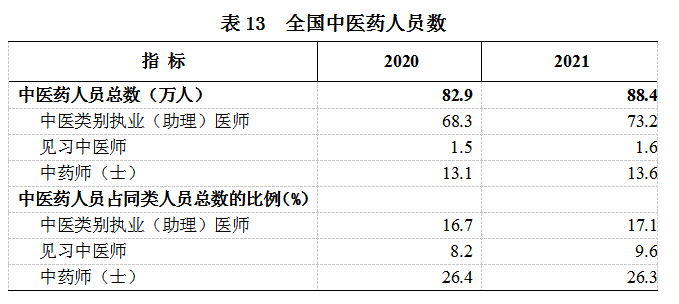
In 2021, the number of discharges from the national medical and health institutions nationwide was 3.802 million, an increase of 2.96 million (an increase of 8.4%) over the previous year. Among them: 31.51.9 million Chinese medicine hospitals (82.9%), 8,000 people in the outpatient department of Chinese medicine, 6.475 million people (17.0%) of non -traditional Chinese medicine and health institutions (see Table 14).
five
Patient medical expenses
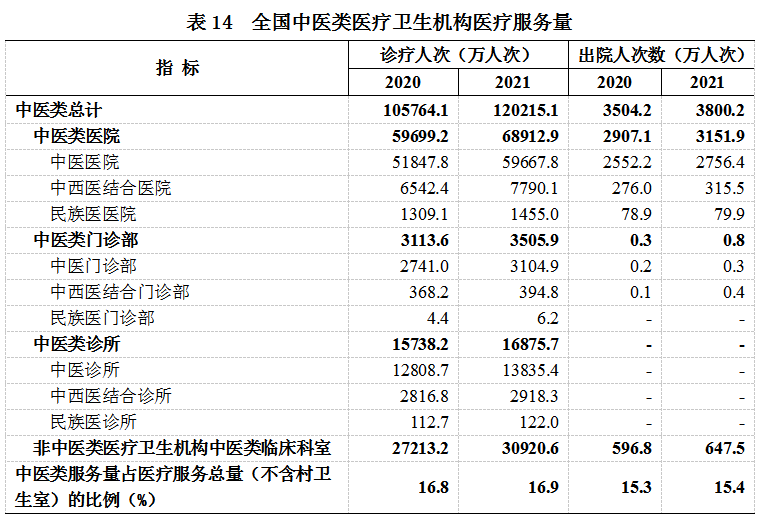
(1) Medical expenses of hospital patients.
In 2021, the average outpatient cost of the hospital was 329.2 yuan, an increase of 1.5%compared with the previous year, and a 0.6%increase of 0.6%at the previous year; %. The average daily hospitalization fee is 1191.7 yuan (see Table 15).
In 2021, the average outpatient medical expenses (123.3 yuan) of the hospital accounted for 37.5%of the average outpatient costs, a decrease of 1.6 percentage points from the previous year (39.1%); 25.1%, a decrease of 1.1 percentage points from the previous year (26.2%). Among public hospitals at all levels in 2021, the average outpatient cost of the third -level hospitals fell by 0.9%(the price of the year, the same below), and the average hospitalization costs fell by 1.1%(see Table 15).
(2) Medical expenses of patients with primary medical and health institutions.
In 2021, the average outpatient cost of the Community Health Service Center was 164.3 yuan, a decrease of 1.0%from the previous year, and a decrease of 1.8%at the comparable price; the average hospital hospitalization fee was 3649.9 yuan, which was 2.5%increased by the price of the year. The price rose 1.6%(see Table 16).
In 2021, the average outpatient medical expenses (118.9 yuan) of the community health service center accounted for 72.4%of the average outpatient costs, a decrease of 2.9 percentage points from the previous year (75.3%); The cost of 29.8%, a decrease of 1.8 percentage points from the previous year (31.6%).
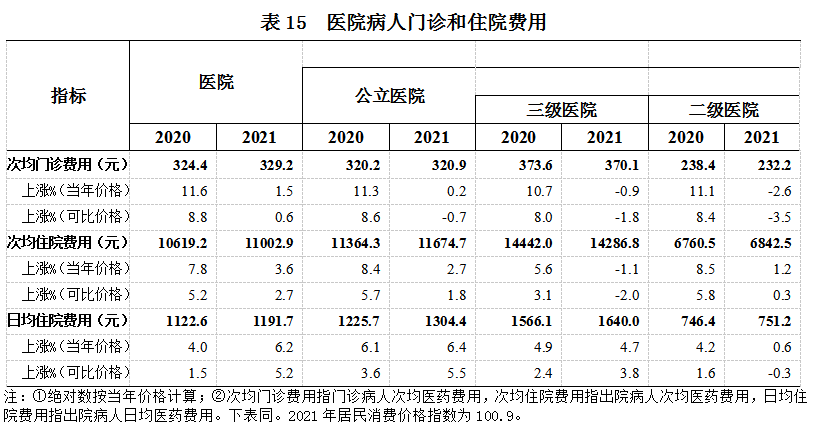
In 2021, the average outpatient cost of the township health centers was 87.5 yuan, an increase of 3.3%from the previous year, and an increase of 2.4%at the comparable price. Retoning 3.1%. The average daily hospitalization fee is 329.3 yuan (see Table 16).
In 2021, the average outpatient medical expenses (51.5 yuan) of the average outpatient medical expenses (51.5 yuan) accounted for 58.9%of the average outpatient costs, a decrease of 2.3 percentage points from the previous year (61.2%); 33.2%, a decrease of 1.9 percentage points from the previous year (35.1%).
six
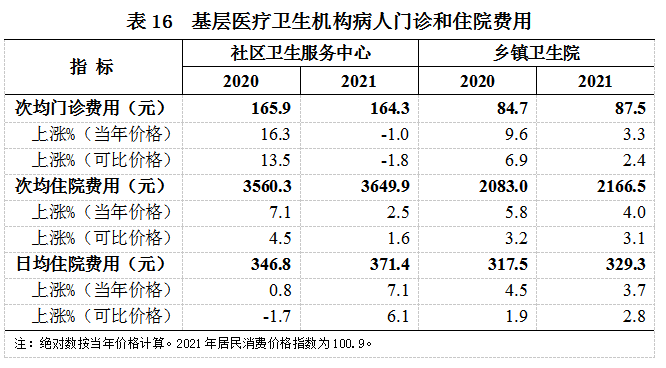
Disease Control and Public Health
(1) Prevention and control of new crown pneumonia.
In 2021, 31 provinces (autonomous regions, municipalities) and Xinjiang Production and Construction Corps reported 15,243 cases of new crown pneumonia, including 6,866 input cases and 8377 local cases; 6,265 asymptomatic infections, including 5047 cases of overseas input cases. There are 1218 local cases. There were 1,2725 cases of hospitalization in the annual report, of which 6331 cases were entered overseas, and 6394 were local cases; 2 cases of death cases.
Further improving the prevention and control policy system of the epidemic, unwavering adhere to the general strategy of "external defense input, internal prevention and rebound", "dynamic clear zero" general policy, adhere to people, physical, and environmental defense, revise 85 key places, key units, key units, and key units. 2. Practical prevention and control related protective protection guidelines for key population epidemics, and revising the "New Coronatte Pneumonic Pneumonia Prevention and Control Plan (Eighth Edition)" and "New Coronatte Pneumonic Pneumonia Diagnosis and Treatment Plan (Trial Eighth Edition Revised Edition)" and other schemes.
As of December 31, 2021, a total of 2835.35 million doses were completed with a total of 2835.35 million doses, and the number of people who completed the whole process was 1210.685 million. /Sky, nucleic acid detection capacity has improved significantly; there are more than 800 designated hospitals in new crown pneumonia across the country.
(2) Infectious disease reporting and death.
In 2021, there were 2727,000 cases of infectious diseases in the country A and B, and 22,000 deaths reported. The top five of the reports are viral hepatitis, tuberculosis, syphilis, gonorrhea, and Brucelli disease, accounting for 93.3%of the total number of infectious diseases in infectious diseases. The top five reports are AIDS, tuberculosis, viral hepatitis, rabies, and epidemic hemorrhage fever, accounting for 99.7%of the total number of deaths in the infectious disease report (see Table 17).
In 2021, the incidence of the national Class A and B infectious diseases was 19.346/100,000, and the mortality rate was 15733/100,000.
In 2021, 11 types of C -type infectious diseases in the country reported a total of 3.506 million cases and 19 deaths. The top 5 diseases reported in order are hand, foot and mouth disease, other infectious diarrhea, epidemic colds, epidemic mumps, and acute hemorrhagic conjunctivitis, accounting for 99.9%of the total number of diseases in the infectious disease report. The number of diseases with a large number of deaths is hand -foot, foot and mouth disease, other infectious diarrhea, and epidemic colds, accounting for 94.7 % of the total death of class C infectious diseases (see Table 18).
In 2021, the incidence of national C infectious diseases was 24.871/100,000, and the mortality rate was 0.0013/100,000.
(3) Prevention and treatment of hemorrhoids.
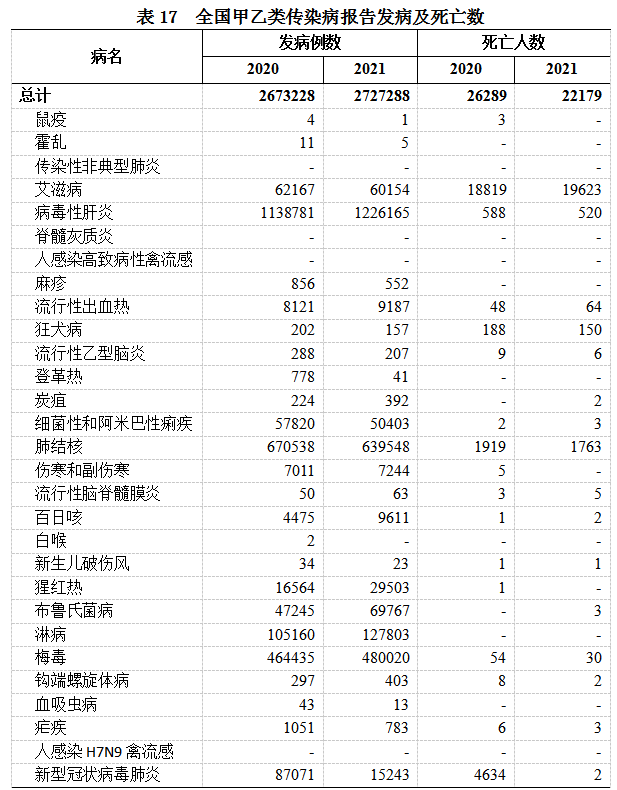
At the end of 2021, there were 451 counties (cities, districts) across the country (cities, districts) across the country; counties (cities, districts) that achieved elimination, dissemination, and dissemination control were 339, 100, and 12, respectively. 29,037 patients, a decrease of 480 from the previous year. (4) Local disease prevention and treatment.
At the end of 2021, there were 330 counties (cities, districts) in Keshan Pathopathy in the country, and 330 have been eliminated, and 44,000 patients with existing symptoms were eliminated. There are 172,000 patients with symptoms; 2,799 countless counties (cities, districts) are eliminated, and 2799 are eliminated. There are 1,041 counties (cities, districts) of local fluorosis (drinking water), control 953, 73,902 villages (neighborhood committees), 298,000 patients at 8-12 years old, and patients with fluorosidomy. 66,000 people; 171 counties (cities, districts) in the ward of local fluorine poisoning (coal-fired pollution), 171 controls, 55,000 patients at 8-12 years old, and 154,000 patients with fluorosidosis Essence

(5) Comprehensive prevention and treatment of chronic diseases.
Implement the comprehensive prevention and control strategy and measures of chronic diseases, and innovate the working model of chronic disease prevention and control. As of the end of 2021, the construction of 488 national chronic disease comprehensive prevention and control demonstration zones, 2855 counties (cities, districts) across the country launched a healthy lifestyle action of the people, and 605 death monitoring points and 2085 tumor registration points were established nationwide. In 2021, in 31 provinces (autonomous regions, municipalities) and Xinjiang Production and Construction Corps, they carried out early treatment of key cancers such as esophageal cancer, gastric cancer, and liver cancer on 3.116 million high -risk groups. Thousands of people, the annual free oral examination of children's oral disease intervention is 4.844 million people.
(6) Severe mental disorder management services.
The health and health departments at all levels, together with the public security, civil affairs, disabled federations and other departments, improve the management service network of serious mental disorders. As of the end of 2021, in 31 provinces (autonomous regions, municipalities) and Xinjiang Production and Construction Corps, a serious mental disorder management and therapy service network was established. Under the guidance of professional health professional institutions, grass -roots medical personnel regularly conducted regularly with 6.31 million patients with severe mental disorders. Follow -up management and rehabilitation guidance.
(7) Control of major diseases and health hazards.
In 2021, the urban and rural drinking water quality monitoring was carried out in all counties and districts across the country. A total of 135,000 monitoring points were set up, 270,000 water samples were collected to conduct water quality testing; 167 monitoring points were set up in 87 cities to carry out air pollution (haze) Monitoring on the health of the crowd; set up public places monitoring points in 132 cities, and monitor health hazard factors for 7,240 public places.
In 2021, in 8710 schools in 1606 counties (cities, districts), common disease monitoring of students was carried out, and a total of 27.36 million were monitored. Adolescent myopia monitoring has a total of 3.739 million people.
(8) Professional disease prevention and control.
As of the end of 2021, there were 1022 vocational health technology service institutions, 605 radiation health technology service agencies, 23 chemical toxicity appraisal centers, 5067 occupational health inspection institutions, 588 occupational disease diagnostic institutions; 671 local capital construction construction of 671 local capital construction Pneumoconiosis rehabilitation station (point) covers nearly 170,000 patients with pneumoconiosis in the area, and patients are satisfied with 96%of rehabilitation services. In 2021, there were 1,5407 cases of various types of occupational diseases in 2021, of which 11,877 cases of occupational pneumoconiosis and other respiratory diseases (including 11,809 cases of occupational pneumoconiosis), 2123 cases of occupational otolaryngomyard disease, and 339 cases of professional infectious diseases. , 567 cases of occupational chemistry poisoning, 283 cases of occupational diseases caused by physical factors, 83 cases of occupational skin diseases, 79 cases of occupational tumors, 43 cases of occupational eye diseases (including 5 radioactive cataracts), and 5 cases of professional radioactive diseases. 8 cases of occupational diseases.
seven
Maternal and child health and health aging
(1) Maternal and child health care.
In 2021, the prenatal examination rate of maternity gynecology was 97.6%, and the postpartum visits were 96.0%. Compared with last year, the prenatal inspection rate and postpartum visits have increased (see Table 19). The hospital delivery rate in 2021 was 99.9%(100.0%of the city, 99.9%of the county), and basically achieved all hospitalization delivery.
In 2021, the management rate of children under 3 years of age reached 92.8%, which was basically the same as the previous year; the system management rate of maternity system reached 92.9%, which was slightly improved over the previous year (see Table 19).
(2) Child mortality under 5 years of age.
According to the national maternal and child health monitoring, in 2021, the mortality rate of children under the age of 5 was 7.1 ‰, of which: cities 4.1 ‰, rural areas of 8.5 ‰; baby mortality rate of 5.0 ‰, of which: city 3.2 ‰, rural areas of 5.8 ‰. Compared with the last year, the mortality rate and infant mortality rate of children under the age of 5 have decreased to varying degrees (see Table 20). (3) Maternal mortality rate.
According to the national maternal and child health monitoring, in 2021, the mortal mortality rate of maternal mothers in the country was 16.1/100,000, of which: 154/100,000 in cities and 165/100,000 rural areas. Compared with the last year, the mortality rate of maternal mothers in the country declined (see Table 20).
(4) National free pre -pregnancy eugenics inspection project.
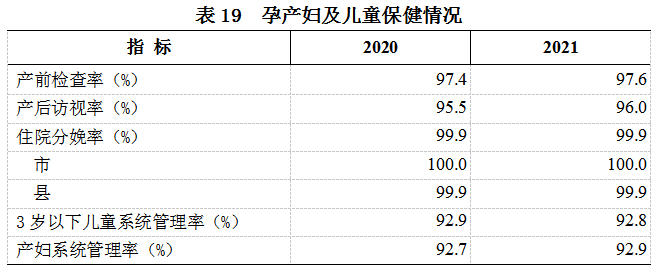
All counties (cities and districts) nationwide generally carry out free pre -pregnancy health examinations to provide free pre -pre -pre -pre -pre -pre -pre -pregnancy service services for health education, health inspections, risk assessment, and consultation guidance for pregnant couples. In 2021, a total of 8.23 million pregnant couples were provided for free inspections. The average target crowd coverage rate reached 93.5%. The screened risk groups have obtained targeted consultation and guidance and treatment referral services, which have implemented pre -pregnancy prevention measures and effectively reduced the risk of birth defects.
(5) Promote the combination of health services with elderly and medical care.
As of the end of 2021, there were 6 national elderly disease clinical medical research centers in the country; 4,685 comprehensive hospitals with secondary and above in the elderly medical department, 5,290 comprehensive hospitals for elderly friendly medical institutions, 15431 primary medical and health institutions 15431 There are 1,027 medical and health institutions with end care (tranquil treatment) department. The national medical and health institutions and pension service institutions have established 78,000 partnerships; there are 6,492 medical and nursing institutions that have two certificates (referring to medical institution's practice permits or filing and filing for pension institutions). The Ministry of Industry and Information Technology and the Ministry of Civil Affairs launched a pilot demonstration of smart health care for the 2021, determining 35 demonstration enterprises, 2 demonstration parks, 45 demonstration streets (townships), and 17 demonstration bases.
Eight
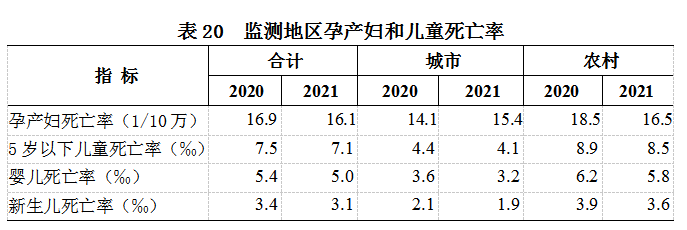
Food Safety and Health Supervision
(1) Monitoring of food safety risk.
According to the reports of the provinces (autonomous regions, municipalities) and Xinjiang Production and Construction Corps, as of the end of 2021, 2,778 food safety risk monitoring points were set up in the country, and 113,000 samples were monitored to 26 major categories; Institutions carried out the monitoring of food -based diseases. The country reported that a total of 5,493 outbreaks of food -based diseases were reported, 32,334 were onset, and 117 were killed.
(2) Sanitary supervision of public places.
In 2021, there were 1.596 million supervision units in public places nationwide and 8.061 million employees. It was supervised and inspected public places 1.842 million households, and 106,000 cases were investigated and punished in accordance with the law.
(3) Drinking water hygiene supervision.
In 2021, 104,000 supervised units in the country's drinking water sanitation (water supply) nationwide, 744,000 people directly engaged in supply and water management. The supervision and inspection of the sanitary (water supply) of drinking water (water supply) is 130,000 households. There are 6,346 supervisors of drinking water hygiene and safety products across the country and 125,000 employees. 7,214 households involving drinking water hygiene products. Investigate and deal with life drinking water and 4,079 cases involving drinking water safety products.
(4) Smart and sterilized sterilization and sterilization of disinfection products and tableware.
In 2021, there were 10,817 supervisors of the national disinfection products and 212,000 employees. The supervision and inspection of disinfection products is 31,000 households, 12,673 sampling inspections, and 96.8%of the pass rate. 2,529 cases were investigated in accordance with the law. In 2021, there were 4018 centralized disinfection service units of tableware and beverage and 44,000 employees. Supervision and inspection 8797 households, investigating 1,475 cases in accordance with the law.
(5) School sanitary supervision.
In 2021, 194,000 were supervised across the country, 233,000 were supervised and inspected, and 7,329 cases were investigated.
(6) Occupational hygiene and radiation hygiene supervision.
As of the end of 2021, 6,725 households have been regulated in regular supervision of occupational health inspection, occupational disease diagnosis, and radiation health technology institutions, and the supervision coverage rate was 75.2%. 598 cases were investigated in accordance with the law. Radiation diagnosis and treatment were supervised by 77,000 units, with a supervision coverage of 77.6%, and 86,000 households were performed. 7705 radiation health cases were investigated and dealt with in accordance with the law.
(7) Medical, health, blood safety, and infectious disease prevention and control and hygiene supervision.
In 2021, 42,000 health administration was imposed on medical institutions or medical staff in accordance with the law. There are 12,000 medicines for administrative penalties. In accordance with the law, 57 administrative penalties were imposed on the blood supply supply institution. 79,000 cases of infectious disease prevention and treatment cases were investigated and dealt with, of which 79,000 cases of administrative penalties for health were under the law.
(8) Maternal and child health supervision.
In 2021, there were 200,000 supervisors of maternal and child health. 29,000 households were supervised and inspected by the supervision and inspection of maternal and child health.
(9) Supervision and enforcement of professional health and technical service agencies for employers.
In 2021, 200,000 households were supervised and inspected nationwide, and 17,308 cases were investigated and punished. In 2021, 1042 households in the country's supervision and inspection of professional health technology service agencies, and 59 cases were investigated and dealt with.
Nine
Population development
There were 10.62 million people born in 2021. Two children account for 41.4%, three children and above account for 14.5%, and the gender ratio of the birth population is 110.9. In 20121 Essence Family planning family awards and assistance "three systems" invested a total of 24.08 billion yuan, an increase of 1.68 billion yuan over the previous year; the central financial investment funds were 13.24 billion yuan, an increase of 750 million yuan over the previous year.
annotation:
(1) Medical and health institutions include hospitals, grassroots medical and health institutions, professional public health institutions, and other institutions.
(2) Public hospitals refer to hospitals (including government -run hospitals) that are state -owned and collective.
(3) Private hospitals refer to hospitals other than public hospitals, including joint venture, joint -stock cooperation, private, Taiwan -Hong Kong -Macao investment and foreign investment.
(4) Primary medical and health institutions include community health service centers (stations), street health centers, township health centers, village clinics, outpatient departments, clinics (medical rooms).

(5) Professional public health institutions include disease prevention and control centers, specialized disease prevention and control institutions, maternal and child health institutions, health education institutions, emergency centers (stations), blood collection institutions, health supervision institutions, and family planning technology service institutions.
(6) Government medical and health institutions refer to medical and health institutions organized by administrative departments such as health, education, civil affairs, public security, judicial, and military regiments.
(7) Traditional Chinese medicine medical and health institutions include traditional Chinese medicine, combination of traditional Chinese and western medicine, hospitals, outpatients, clinics and scientific research institutions.
(8) Health personnel include health technicians, personnel with rural doctors and health staff, other technical personnel, managers, and workers. According to statistics from the number of employees in the job, including personnel, contract system, return, and personnel for more than half a year.
(9) Health technicians include practicing (assistant) physicians, registered nurses, pharmacists (scholars), technicians (scholars), health supervisors (including the number of health supervisors in civil servants), and other health technicians.
(10) Practice (assistant) Physician refers to those who have obtained a physician's practice certificate and actually engaged in clinical work.
(11) Registered nurses refer to those who have obtained a registered nurse certificate and actually engaged in nursing work.
(12) Number of health technicians, practicing (assistant) doctors, number of registered nurses, number of general doctors, number of professional public health institutions, and medical and health institutions per 1,000 population health technical personnel, and the number of bedside in medical and health institutions are calculated according to the permanent population.
(13) Residents' per capita life expectancy results in 2021 are initial calculation data, and 2020 is the seventh census data.
Source: official website of the National Health and Health Commission

- END -
Do a good job of grabbing the field of water, etc. to prevent secondary disasters from occurring
In order to effectively reduce the loss of typhoon disasters to agricultural production, and restore agricultural production as soon as possible, the Municipal Agricultural and Rural Bureau organized
Make the community party building work in the hearts of the masses
[Our new era]In 2006, I came to work in Bei'anmen Community. Here is the old community, and there are more than 10,000 residents, with a population ratio of over 22%. At first I was a little retreated...